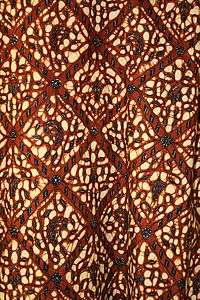Sanforization
_(14765101194).jpg)
Sanforization is a process of treatment used for cotton fabrics mainly and most textiles made from natural or chemical fibres, patented by Sanford Lockwood Cluett (1874–1968) in 1930.[1] It is a method of stretching, shrinking and fixing the woven cloth in both length and width before cutting and producing, to reduce the shrinkage which would otherwise occur after washing.
The cloth is continually fed into the sanforizing machine and therein moistened with either water or steam. A rotating cylinder presses a rubber sleeve against another, heated, rotating cylinder. Thereby the sleeve briefly gets compressed and laterally expanded, afterwards relaxing to its normal thickness. The cloth to be treated is transported between rubber sleeve and heated cylinder and is forced to follow this brief compression and lateral expansion, and relaxation. It is thus shrunk.
The greater the pressure applied to the rubber sleeve during the sanforization process, the less shrinking will occur once the shirt is in use. The process may be repeated.
The aim of the process is a cloth which does not shrink significantly during production by cutting, ironing, sewing or, especially, by wearing and washing the finished clothes. Cloth and articles made from it may be labelled to have a specific shrink-proof value (if pre-shrunk), e.g., of under 1%.
Notes
- ↑ Simpson, J. R.; Weiner, E. S. C. (1989). The Oxford English dictionary. Oxford: Clarendon Press. ISBN 0-19-861186-2.


.svg.png)